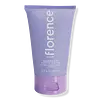What's inside
What's inside
 Key Ingredients
Key Ingredients

 Benefits
Benefits

 Concerns
Concerns

 Ingredients Side-by-side
Ingredients Side-by-side

Water
Skin ConditioningKaolin
AbrasiveMagnesium Aluminum Silicate
AbsorbentCharcoal Powder
AbrasivePropylene Glycol
HumectantCucumis Sativus Fruit Water
Skin ConditioningAloe Barbadensis Leaf Juice
Skin ConditioningLavandula Angustifolia Oil
MaskingMelaleuca Alternifolia Leaf Oil
AntioxidantSalicylic Acid
MaskingCaprylyl Glycol
EmollientEthylhexylglycerin
Skin ConditioningGlycerin
HumectantHectorite
AbsorbentXanthan Gum
EmulsifyingButylene Glycol
HumectantSodium Salicylate
PreservativePotassium Sorbate
PreservativeCitric Acid
BufferingSodium Benzoate
MaskingLinalool
PerfumingCI 77499
Cosmetic ColorantWater, Kaolin, Magnesium Aluminum Silicate, Charcoal Powder, Propylene Glycol, Cucumis Sativus Fruit Water, Aloe Barbadensis Leaf Juice, Lavandula Angustifolia Oil, Melaleuca Alternifolia Leaf Oil, Salicylic Acid, Caprylyl Glycol, Ethylhexylglycerin, Glycerin, Hectorite, Xanthan Gum, Butylene Glycol, Sodium Salicylate, Potassium Sorbate, Citric Acid, Sodium Benzoate, Linalool, CI 77499
Water
Skin ConditioningPentylene Glycol
Skin ConditioningDiglycerin
HumectantSpirulina Platensis Extract
Skin ProtectingPanthenol
Skin ConditioningFructooligosaccharides
HumectantCoconut Acid
CleansingBeta Vulgaris Root Extract
Skin ConditioningArginine
MaskingGlycogen
HumectantSalvia Hispanica Seed Extract
EmollientDipotassium Glycyrrhizate
HumectantPotassium Sorbate
PreservativeSodium Hyaluronate
HumectantCarrageenan
Lactobacillus Ferment
Skin ConditioningLeuconostoc/Radish Root Ferment Filtrate
AntimicrobialGlucomannan
Skin ConditioningLinolenic Acid
CleansingWater, Pentylene Glycol, Diglycerin, Spirulina Platensis Extract, Panthenol, Fructooligosaccharides, Coconut Acid, Beta Vulgaris Root Extract, Arginine, Glycogen, Salvia Hispanica Seed Extract, Dipotassium Glycyrrhizate, Potassium Sorbate, Sodium Hyaluronate, Carrageenan, Lactobacillus Ferment, Leuconostoc/Radish Root Ferment Filtrate, Glucomannan, Linolenic Acid
Alternatives
Ingredients Explained
These ingredients are found in both products.
Ingredients higher up in an ingredient list are typically present in a larger amount.
Potassium Sorbate is a preservative used to prevent yeast and mold in products. It is commonly found in both cosmetic and food products.
This ingredient comes from potassium salt derived from sorbic acid. Sorbic acid is a natural antibiotic and effective against fungus.
Both potassium sorbate and sorbic acid can be found in baked goods, cheeses, dried meats, dried fruit, ice cream, pickles, wine, yogurt, and more.
You'll often find this ingredient used with other preservatives.
Learn more about Potassium SorbateWater. It's the most common cosmetic ingredient of all. You'll usually see it at the top of ingredient lists, meaning that it makes up the largest part of the product.
So why is it so popular? Water most often acts as a solvent - this means that it helps dissolve other ingredients into the formulation.
You'll also recognize water as that liquid we all need to stay alive. If you see this, drink a glass of water. Stay hydrated!
Learn more about Water